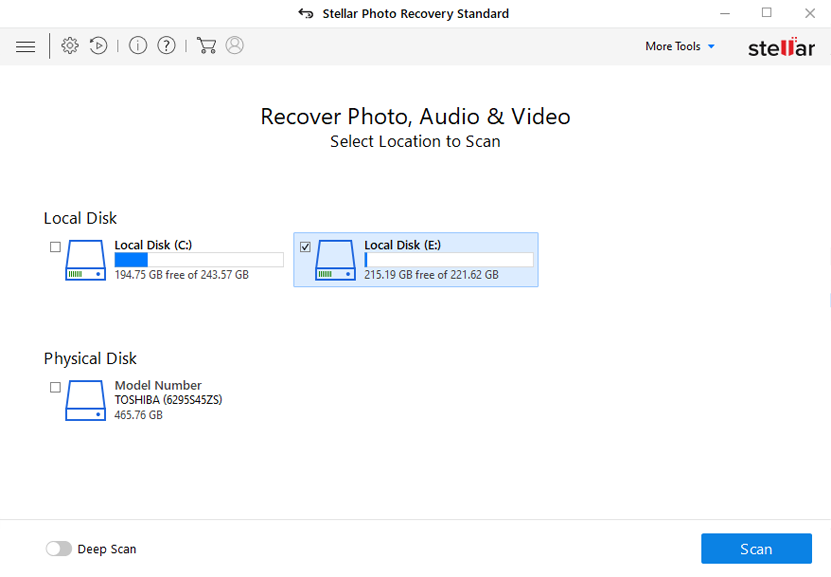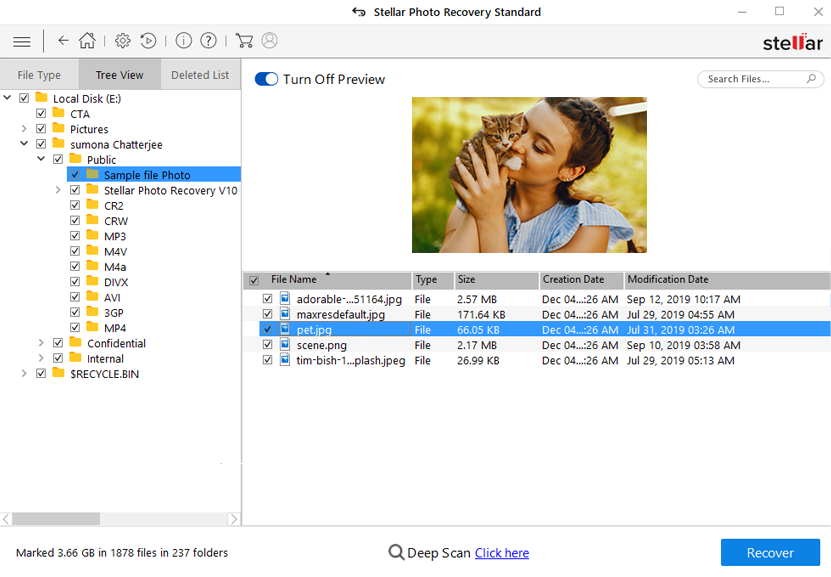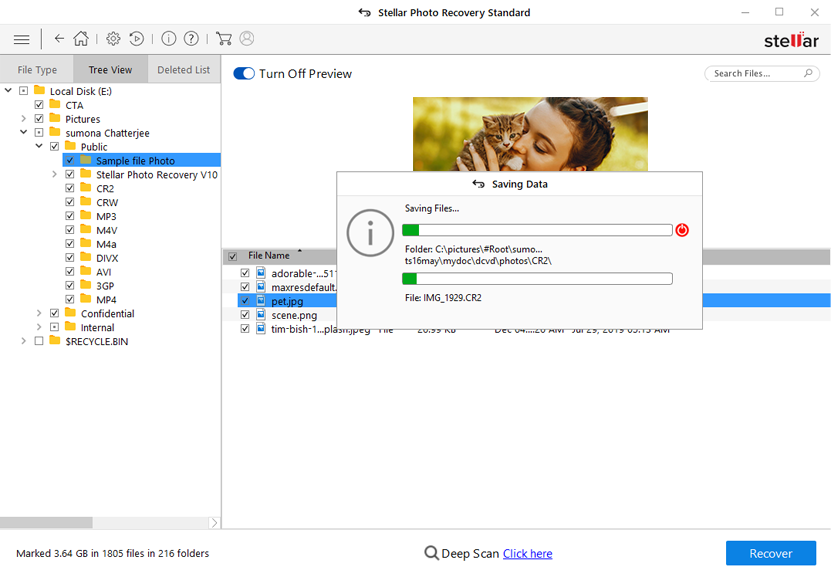Summary: Is your SSD crashed, failed or dead? Are you looking for a reliable and perfect solution to recover data from SSD drive that has become failed/dead or crashed? Don’t worry and be calm! This particular blog post will help you to recover data from crashed, failed or dead SSD drive. Simply read the article and follow the solution.
To recover data from crashed, failed or dead SSD drive, we recommend this tool:
This software will restore data from corrupted, formatted, encrypted storage media and works in all data loss situations. Now recover your lost and deleted data in 3 easy steps:
- Try this Data Recovery Tool rated Excellent on Pcmag.com.
- Select the storage media from which you want to restore the media files & click Scan.
- Preview the recoverable files, select the items you want to recover and click Recover to save the files at desired location.
- What Makes SSD Drives Fails, Crashed or Dead?
- Is It Possible To Recover Files From Dead, Failed or Crashed SSD?
- Best Way To Recover Data From Dead, Crashed Or Failed SSD Drive
- Related SSD Drive Issues And Solutions
- Precautionary Measures
Solid State Drive (SSD) is, of course, a hard drive but it is different from normal hard drive (HDD). SSD is a persistent data storage device and it provides faster data access, low power consumer, high performance and many more benefits. In comparison to hard drives, SSD provides more shock resistance power. Since SSD does not have any movable parts, it provides high reliability and longevity to its users.
As per the analysis was done by Tom’s Hardware, SSDs are reliable for the first few years and depend upon the write cycle that could actually last for over a decade.
Given the statistics, SSDs still get crashed, fail or completely become dead even though they have few mechanical parts.
After doing some deep research and going through several forums and community websites I have come to the conclusion that there are many people using SSD drive are asking questions to get appropriate solutions.
The questions are as follows:
- How to Recover Data off dead SSD?
- If an SSD crashed, can files on it be restored?
- Can data be recovered from failed SSD?
- What to do when my SSD dead/crashed/failed with no backup?
Just have look at the user’s practical scenarios mentioned-below!
Practical Scenario: User Looking For Solutions To Recover Data Off Failed SSD
Recover data from failed SSD?
Hi I am having problems recovering data from my SSD. It started with Windows 7 not being able to boot and now the OS on my other computer is having a hard time seeing the SSD at all. The bios however can still see my SSD. Is there any way I can recover at least some data from my SSD? Any help would be greatly appreciated and if you need any more information just let me know. Thanks.
– Original Post From Tom’s Hardware Forum
Users always ask such related questions on crashed/dead SSD recovery when they encounter unexpected data loss tragedy caused by SSD drive failure or crash.
But what makes SSD fail, crash or completely dead?
What Makes SSD Drives Fails, Crashed or Dead?
There could be few factors that can lead to SSDs to fails, crash or dead. They are as follows:
- Failure of electronic components (malfunction of capacitors or transistors).
- When there is a fluctuation in the power supply.
- Controller chip behaving weird.
- Severe infection of virus.
- Corrupt master boot record.
- Excessive formation of bad sectors.
- Aged or over usage of the SSD drive.
Even though SSDs have lesser mechanical components, but still they get degraded with time. Additionally, material defects can also affect the reliability and longevity of the SSD drives over a period of time. And SSDs are another part of computer components, wear and tear also lead to the SSD failure.
So, now the question arises – Can Data Be Recovered From A Dead SSD Hard Drive?
Find the answer by yourself below!
Can Data Be Recovered From A Dead SSD Hard Drive?
Yes, we can here confirm that it is definitely possible to recover data off dead, crashed, corrupted or failed SSD drive with the help of suitable SSD data recovery software.
There are many users who do not know anything about dead SSD data recovery. But if you find the right solution to get back your data, then it becomes very much easier.
So, what are the right and best way for dead, crashed or failed SSD Data Recovery?
Best Way To Recover Data From Failed SSD Hard Drive
When it comes to the SSD drive recovery, you can easily recover from the backup folder if you have kept it somewhere before the file deletion takes place. Or, you can also try SSD Drive Data Recovery Tool. This recovery tool will help you to recover data from dead SSD hard drive.
This data recovery is designed to recover files from dead SSD drive on Windows and Mac system as this software is available for both Windows and Mac computer separately.
This dead SSD Drive Data Recovery tool is fast and comes with advanced scanning algorithms that efficiently extract lost, missing or inaccessible data from Solid State Drive. Do note that this crashed SSD drive file recovery tool only recover photos, videos and audio of various file formats from dead and crashed hard drive.
Below download SSD Drive Data Recovery Tool and follow the step-by-step guide on how to recover data from dead SSD hard drive.
With the use of SSD Drive Data Recovery Tool, you can:
- Retrieve inaccessible or lost pictures, videos and audio files of various formats from dead, crashed or failed SSD.
- Also recover data from Windows or Mac internal or external hard drive data.
- Support all brands of SSD drive manufactured by PNY, Transcend, Toshiba, Samsung 850 Pro, SanDisk G26 Plus, Crucial, WD, Adata, Kingston, etc.
- 100% read-only. Safe, secure and easy to use.


* Free version of the program only scans and previews recoverable objects.
Steps To Recover Photos, Video and Audio Files From Dead/Crashed/Failed SSD Drive
Step 1: Select Desired Location
Firstly, select the drive, external media or volume from which you want to recover deleted media files. After selecting, click on 'Scan'.

Step 2: Preview Recovered Media Files
Next, you can preview the recoverable media files after the scanning process is completed.

Step 3: Recover Media Files
Lastly, you can select the images, audio, video files you want to restore and click on 'Recover' option to save them at the location you want.

Related SSD Drive Issues And Solutions
Many people also have other problems and errors related to their SSD drive.
Problems they encounter are with their Mac SSD and the problems are:
- Slow response time.
- The process for accessing files is actually not that fast.
- Lagging issue.
- And so on…
Fix SSD Drive Failure On Mac System
Well, in order to know how to fix a dead SSD, you can use Disk Utilities on your Mac system. Follow the steps mentioned below to fix SSD failure:
- On your Mac, press ‘Command+ Space’ and launch Spotlight Search.
- Now type, ‘Disk Utility’ and hit Enter.
- Select the disk and click on “VerifyDisk, Repair Disk, or First Aid”
- Proceed further after selecting any one of the options.
Tip: This is also one of the best ways to check SSD once in a while to avoid SSD drive failure.
Fix SSD Drive Failure On Windows System
Windows PC also has inbuilt feature to fix bad sector present on SSD drive. So, if your SSD drive contains any bad sector that may lead your SSDs to fail, crash or dead, it is suggested that you must check your SSD to fix bad sectors on Windows SSD.
Here follow the steps:
- On your Windows PC, go to ‘This PC/My Computer’ and then right-click on SSD drive and select the “Properties” option.
- Go to the “Tools” tab and select the “Check Now” option.
- Now, select both check disk options and click on “Start”.
Note: If your SSD drive is slower then, you can select the “Defragment Now” option. Defragmentation will rearrange the files and free space so that Windows OS can quickly access the files.
Precautionary Measures
Let me tell you the truth that recovering data from failed, crashed or dead SSD drive is difficult and expensive. The steps that you take before the drive failed are more effective than the steps you take after.
Since you can’t predict when your SSD will fail, you should treat your Solid State Drive as if it could fail tomorrow.
So, follow these precautionary steps:
- Backup data on I regular basis. Backing up data is one of the best ways to deal with data loss scenarios. You can use that backup file when your SSD dies, crash or fail.
- It is important that you must update your antivirus program installed on your system to avoid any kind of virus or malware infection to SSD.
- Do not move ahead blindly, when you get any unknown logical errors conflicts in SSD drive.
Conclusion
The only bet way to make sure that you don’t lose your important data is to have a valid backup of your SSD drive. Backed up data will help you to recover files from the backup folder if you encounter any data loss. But in the absence of backup, you can rely upon SSD drive data recovery tool and double the chances for recovering files from failed, crashed or dead SSD efficiently.
You can also take some precautionary measures to avoid data loss from dead or crashed SSD hard drive. These tips will help you recover data from failed SSD hard drive.

Taposhi is an expert technical writer with 5+ years of experience. Her in-depth knowledge about data recovery and fascination to explore new DIY tools & technologies have helped many. She has a great interest in photography and loves to share photography tips and tricks with others.